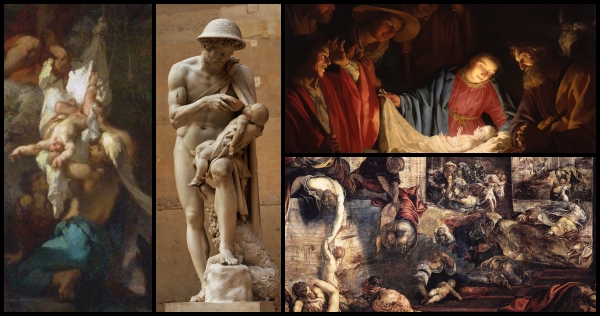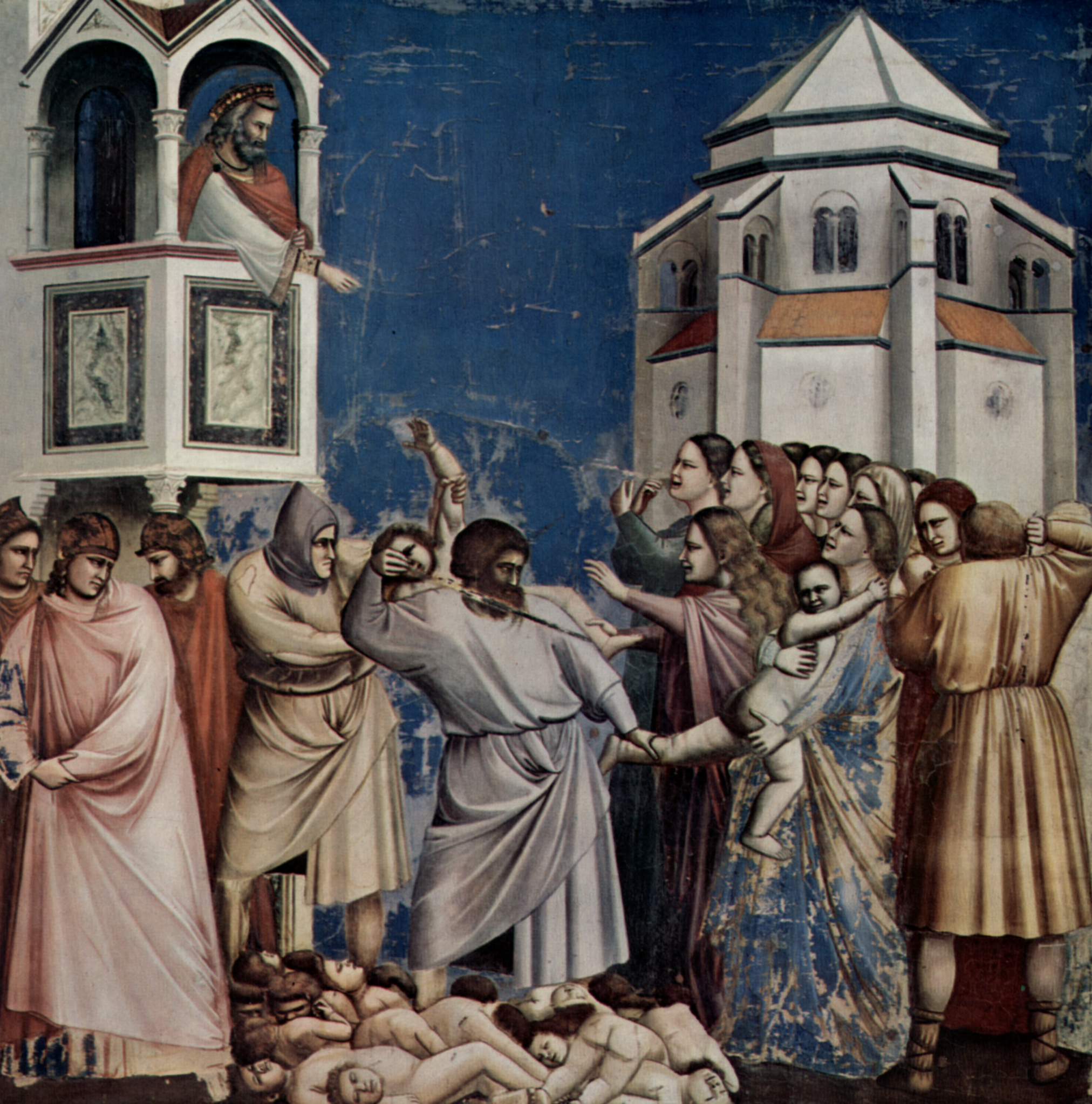Shepherds in Shakespeare, Oedipus, Hamlet, and the Bible
Shakespeare’s Hamlet is often analyzed in terms of Freud’s theories that draw upon the Greek tale of Oedipus. When Hamlet blindly stabs Polonius behind the arras, this may resemble Oedipus unknowingly killing his own estranged and bullying father on the road.
Hamlet refers to Herod, possibly Herod the Great or his son, Herod Antipas. A few days after Christmas, Christian churches commemorate Herod the Great’s slaughter of innocent boys. The tale claims that Herod heard of the birth of a new king of Israel, so he tried to avoid being replaced by killing all young male infants (collage, bottom right) [1].
Shepherds in the gospel tale choose a different path: They hear from angels of the birth and go to adore the infant Jesus (collage, top right) [2]. The shepherds could be said to mediate between angels and Jesus, who will come to be called a “good shepherd.” .
In the Oedipus tale, Laius, father of Oedipus, fears a prophecy that his son will one day kill him; he tells his wife Jocasta to kill the child. She cannot, so she passes the job to a servant; the servant cannot.
The servant passes the child to a shepherd who unbinds the boy, tends his wounds as he might an injured lamb, nurses him to health (collage, center left) [3], and gives him to adoptive parents better suited to the task than Laius. The shepherd is in that way like Hermes, unknowingly a kind of messenger, mediator or translator between the dysfunctional birth father, and his more nurturing adoptive family of Polybus and Merope.
In Shakespeare’s A Winter’s Tale, a shepherd similarly plays an important transitional role, adopting Perdita, a foundling who will later be recognized as the princess daughter of Leontes, jealous King of Sicilia.
In some accounts the infant Oedipus, ankles bound by his father, is hung upside down in a tree to die, strung up like hunter’s meat (collage, far left) [4]. Another illustration by Salvator Rosa also shows Oedipus hung by his ankles, with a faint cross above the tree, implying that Oedipus is a type of Christ who was also hung on a tree (crucifixion) [5].
In Shakespeare’s Hamlet, the sentinels and gravedigger play mediating roles similar to the Oedipal shepherd:
— The sentinels see the ghost, ask Horatio to keep watch with them, and then report the sighting to Hamlet.
— The gravedigger/sexton/clown is a shepherd of graves and bones, identifying a particular skull as that of Yorick, Hamlet’s beloved court jester and fool who once poured a flagon of Rhenish wine on the gravedigger’s head. This reunites Hamlet with the memory of his emotional surrogate father, Yorick, in a way similar to the Oedipal shepherd conveying the infant Oedipus to his adoptive parents, Polybus and Merope.
In these ways, shepherds in Shakespeare, the Bible, and the Oedipus tale play rich roles as caretakers and mediators.
IMAGES & NOTES: All references to Hamlet are to the Folger Shakespeare Library online version: https://shakespeare.folger.edu/shakespeares-works/hamlet/entire-play/
[1] Jacopo Tintoretto (1519–1594) “The Massacre of the Innocents,” between 1582 and 1587.
Sala terrena, Scuola Grande di San Rocco. Public domain, via https://en.wikipedia.org/wiki/File:Jacopo_Tintoretto_-_The_Massacre_of_the_Innocents_-_WGA22591.jpg
See also Peter Paul Rubens (1577–1640), "The Massacre of the Innocents," between 1611 and 1612, Art Gallery of Ontario. Public domain via https://commons.wikimedia.org/wiki/File:Rubens_-_Massacre_of_the_Innocents_-_Art_Gallery_of_Ontario_2.jpg
See also Giotto (1266–1337), "The Massacre of the Innocents," between 1304 and 1306, Scrovegni Chapel. Public domain via https://en.wikipedia.org/wiki/File:Giotto_di_Bondone_-_No._21_Scenes_from_the_Life_of_Christ_-_5._Massacre_of_the_Innocents_-_.jpg
See also Matteo di Giovanni (1435–1495), "Massacre of the Innocents," 1488, National Museum of Capodimonte. Public domain via https://en.wikipedia.org/wiki/File:Matteo_di_Giovanni_002.jpg
[2] Gerard van Honthorst (1592–1656), “Adoration of the Shepherds,” circa 1622.
Pomeranian State Museum. Public domain via https://en.wikipedia.org/wiki/File:Gerard_van_Honthorst_-_Adoration_of_the_Shepherds_(1622).jpg
[3] Antoine-Denis Chaudet (French, 1763–1810), “The child Œdipus brought back to life by the shepherd Phorbas, who took him off the tree.” Completed by Pierre Cartellier (1757–1831) and Louis-Marie Dupaty (1771–1825) after Chaudet's death. Louvre Museum. Public domain via https://en.m.wikipedia.org/wiki/File:Oedipus_Phorbas_Chaudet_Louvre_N15538.jpg
[4] Jean-François Millet (1814–1875), “Oedipus Taken Down from the Tree,” 1847. National Gallery of Canada. Public domain via https://commons.wikimedia.org/wiki/File:Oedipus-taken-down-from-the-tree-1847.jpg
[5] Salvator Rosa, “The Rescue of the Infant Oedipus,” 1663, National Gallery of Art. Public domain via Creative Commons CC0 1.0 Universal Public Domain Dedication and https://commons.wikimedia.org/wiki/File:Salvator_Rosa,_The_Rescue_of_the_Infant_Oedipus,_1663,_NGA_212409.jpg
~~~~~~~~~~~~~~~~~~~~~~~~~~~~~~~
~~~~~~~~~~~~~~~~~~~~~~~~~~~~~~~
INDEX OF OPHELIA POSTS:
My 2023 series on Ophelia, and earlier Ophelia posts:
https://pauladrianfried.blogspot.com/2023/10/index-of-ophelia-posts-2023-series-and.html
~~~~~~~~~~~~~~~~~~~~~~~~~~~~~~~
~~~~~~~~~~~~~~~~~~~~~~~~~~~~~~~
YOU CAN SUPPORT ME on a one-time "tip" basis on Ko-Fi:
https://ko-fi.com/pauladrianfried
IF YOU WOULD PREFER to support me on a REGULAR basis,
you may do so on Ko-Fi, or here on Patreon:
https://patreon.com/PaulAdrianFried
~~~~~~~~~~~~~~~~~~~~~~~~~~~~~~~
~~~~~~~~~~~~~~~~~~~~~~~~~~~~~~~
Disclaimer: If and when I quote or paraphrase bible passages or mention religion in many of my blog posts, I do not intend to promote any religion over another, nor am I attempting to promote religious belief in general; only to explore how the Bible and religion influenced Shakespeare, his plays, and his age.
~~~~~~~~~~~~~~~~~~~~~~~~~~~~~~~~~~~~~~
~~~~~~~~~~~~~~~~~~~~~~~~~~~~~~~~~~~~~~
Thanks for reading!
~~~~~~~~~~~~~~~~~~~~~~~~~~~~~~~~~~~~~~
~~~~~~~~~~~~~~~~~~~~~~~~~~~~~~~~~~~~~~
My current project is a book tentatively titled Hamlet’s Bible, about biblical allusions and plot echoes in Hamlet.
Below is a link to a list of some of my top posts (“greatest hits”), including a description of my book project (last item on the list):
https://pauladrianfried.blogspot.com/2019/12/top-20-hamlet-bible-posts.html
I post every week, so please visit as often as you like and consider FOLLOWING.
To find the FOLLOW button, go to the home page: https://pauladrianfried.blogspot.com/
see the = drop-down menu with three lines in the upper left.
From there you can click FOLLOW and see options.











Comments
Post a Comment